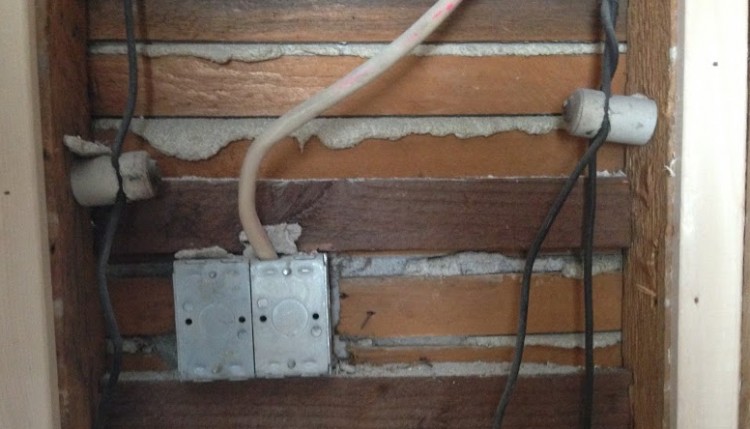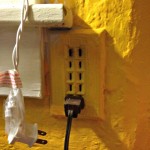I didn't know a whole lot about architecture or housing styles before we started house shopping years back. But the the more homes you look at, the more you start to…

9 things I hate about old houses
You know I love old houses. LOVE them. I honestly don’t think I’d buy a new-construction house even if I could afford one (which I can’t).
Even new condos — I mean, those luxury towers in Boston’s Seaport district are spectacular, sure. But if I had $5 million to blow on housing? I’ll spend half of that to buy two or three old Victorians and invest the rest in fixing them up and restoring them.
But as much as I love old houses, they’re not perfect. Nooooooo, sir. They tend to come with a tackle box: A whole bunch of issues you have to tackle.
Some have never been upgraded, so the wiring or chimney or pipes or all of the above only meet building codes from 100+ years ago. You know, the dawn of electricity.
Others have been updated, but in the 1960s or ’70s — not exactly a “timeless” look.
And then there’s the fact that they’re just plain old. Some of the wood may be rotting, some of the pipes may be rusting.
However, I’ll take an old house 10 times out of 10 just because it’s so old. They really don’t make ’em like they used to. These houses have withstood storms and blizzards and hurricanes, decades of rain and wind and beating sunshine, and they’re still sturdy as hell.
As one contractor told me awhile back, “These houses just keep standing. They don’t know any better.”
It’s hard to say what you’ll get with a new house, certainly one built in the peak of the boom years, when builders could slap up just about anything and sell it for a profit. But you KNOW what you’re getting with an old house, warts and all. Even some of the hazards — like lead paint or asbestos — are known issues at this point with concrete solutions. There’s no lead in a new house, but I’m guessing there’s something else we don’t even REALIZE is bad for you yet. I’ll take my chances with the devil we know.
So here are nine things that suck about old houses — but you should know I still love them anyway.
Knob-and-tube wiring
Until around the 1940s, this was how houses were wired for electricity. Uninsulated (i.e. exposed) wires run inside the walls attached to little porcelain knobs every few feet. The air inside the wall cavity acts as an insulator.
Now, this isn’t a terrible system in theory, if everything goes smoothly. As long as the wires don’t come into contact with anything, they’ll be fine for decades. After all, air is one of the best insulators there is.
However, stuff can happen inside walls — a pipe leaks, a mouse crawls in — and knob-and-tube wiring has been the source of enough fires over the years that insurance companies (and many home buyers) are frightened of it.
Our old Realtor, Jim McGue, told me the danger of K&T is way overblown. “The wiring is perfectly safe — it’s the people who make it dangerous,” he said. “People would hang their wet laundry to dry on the wires down in their basements. Of course it started a fire!”
Either way, old K&T wiring presents two huge problems to a homeowner:
- Home insurance companies view knob-and-tube wiring as a fire hazard, and some won’t even insure your property. (You may have to go with a New England-based insurance company who’s familiar with old houses.)
- You can’t add insulation inside your walls if there’s knob-and-tube wiring in there, because it’s unsafe for the live wires to come into contact with stuff — they need an empty pocket of air in the walls. That makes it really hard to make your home more energy efficient until you upgrade your wiring.
We finally updated all the wiring in our two units, and it cost about $4,000 apiece. A bigger home might cost $5,000. However, an updated electrical system will be pretty valuable to future home buyers – and close to priceless in my mind.
Old pipes
Before people became obsessed with making industrial-looking furniture and home decor out of metal pipes, people used to use them for plumbing. (Now, of course, just about any new plumbing is done with PEX or PVC pipes.)
The plumbing in any given old house is bound to be made from iron, copper, steel, or even brass. And the thing is, what happens to iron-based metal when it comes into contact with water every day for more than a century? It rusts. Not copper, God bless it! Copper just tarnishes, though it can still wear down. But your radiator and drain pipes — your sewer line even – are going to be made out of iron or steel, and that’s gonna get rusty over time. Like holes in the pipe rusty.
And when there’s a hole in your sewer drain? GROSS.
None of this is a huge deal — like wiring, it’s just a pain in the neck (and therefore expensive) to fix, because it’s mostly behind the walls and under floors.
Wrongheaded mid-century updates
Our house was probably a stunner back in the 1920s. However, somewhere along the way, a couple of owners did some stupid stuff.
At one point in the 1940s (best as we can tell), someone blew out a huge opening in the foundation (that’s an important piece of the house!) to create a small garage. It weakened that side of the house, and we now have a pleasant northward tilt. What’s more, the garage they made is carved into the basement, but is entirely blocked off from said basement – it’s like this concrete bunker you can only access from outside. Wildly unhelpful, except to store lawn equipment like our snow blower and lawn mower.
Our kitchen, meanwhile, had last been redone in 1974. We know the exact year by some markings we found underneath the wallpaper — but the mustard-yellow, fondue-pot wallpaper (which literally had glitter on it) and fake wood paneling kind of gave it away even before that. Oh, and the layers and layers and LAYERS of vinyl flooring. On top of the beautiful hardwoods, which we were gratefully able to uncover and refinish.
And sometime in the 1950s or ’60s, the former owners decided to get new siding over the old wooden clapboard shingles. Apparently the aluminum and vinyl siding salesmen missed their house, because we ended up with asbestos-concrete shingles.
Asbestos shingles have their upside — they’re extremely durable and fire retardant, they hold paint really well, and they offer some insulation — it’s just that pesky asbestos! And to be honest, they apparently pose no safety threat if left alone on the side of the house. However, getting the asbestos siding removed would be costly because it needs to be disposed of in a careful and legal manner, and its simple presence can complicate any exterior projects.
Lack of insulation
Our house is terribly drafty. Old houses simply weren’t built with insulation, and it costs more to heat and cool them. That sucks.
I keep meaning to get MassSave in here to do another energy audit since we finally got rid of the knob-and-tube wiring (which was preventing us from getting insulation blown into the walls). MassSave will cover up to 75% of the insulation cost, up to $2,000, but it’s not always quite as simple as that.
Usually, they blow in the insulation through the outside, removing some of the exterior siding one piece at a time. If they can’t do that (and they can’t with our house, because we’ve got said asbestos shingles), they’ll poke holes in your interior walls every 15 inches and plug them up afterward – but you’ll need to paint after, and that’s a whole scene I’m not ready for.
Ghosts
My wife has seen a couple of ghosts in her life, always in very old homes. Not scary ghosts or anything, just the trace energies of people who’d lived there long ago. I’ve never seen a ghost, but I’ve felt their presence twice.
One of those times was during our home search, at a house on Vassall St. in Quincy.
It was a pretty unremarkable house, but within our price range and in the right location, so our Realtor took us to see it. As we walked through the house and into one of the bedrooms upstairs, I became overcome with an inexplicable, foreboding sense of deep sadness. It was overwhelming.
When we left the house, my wife turned to me and said, “Did you feel that?”
I did. Like a child had died there, or some other tragedy.
“Yes, exactly like that.”
“Um…”
“Yeah…”
Our Realtor thought we were crazy, but there was no way we were buying that house.
Creepy basements
When the missus and I were touring house after house in 2008, we just about saw it all. There was the sketchy, unreasonably cheap single family in Roslindale that looked and smelled like it must have housed a dog-fighting ring. There was a tiny house by the beach in Quincy where you couldn’t open the bathroom door all the way, because the toilet blocked it. And there were some truly creepy basements.
The basement is where all the greasy guts of the house are. Hard-working boilers and furnaces, oil tanks, gas pipes, sewer lines, and more. In an old house, there’s bound to be some gross stuff and a few dark, neglected corners down there.
But sometimes there’s dirt floors, or a ghostly vibe, or full-on creeptacular crawl spaces. We saw one house where the side of the basement wall looked like a giant had punched a hole through it — huge boulders of rubble spilled out from this six-foot-wide hole – and behind that was like a dark, dank, hidden basement cavity. No thank you.
Zoning and building restrictions
We have some friends who own a condo in the Back Bay, and after a fire in the building, they had to replace some of the windows. But being the Back Bay and all, they couldn’t just put in regular windows — they had to special order custom curved glass windows that looked original to the building. It took weeks longer, and they were shut out of their apartment the whole time.
Likewise, when we were touring Lunenburg up in Nova Scotia — pretty much the most adorable place EVER — we learned on a tour that because it’s a UNESCO World Heritage site, houses in the downtown area are required to keep their old wood siding, like it or not. They can’t replace it with vinyl, aluminum, or composite siding.
Those are fairly minor examples — more annoyances than true grievances. But historical societies can get pretty nit-picky. And when one of the best things about owning your own home is that you can, in large part, do whatever you want with it, well, that kind of stuff can really clip your wings.
Narrow doorways and stairways
When we moved into our new home, we were surprised to discover that the former owner took her old fridge with her. It wasn’t a real nice fridge, to be honest, so we weren’t too torn up about it. But we had to be very careful about buying a replacement — specifically, one that could fit through our 30-inch doorways and up our narrow, bending stairway. The one we settled on – far smaller than the average American fridge – just made it up those stairs.
Not that we wanted a huge refrigerator — we’d been living in a Back Bay studio with a tiny apartment-sized one, barely bigger than a dorm room beer fridge — but I mean, other people don’t even have to think about this stuff.
Getting a queen bed up here? Not gonna happen, unless it’s got a split box spring or IKEA-style slats.
Then there was our couch fiasco. When the leather on our first couch started peeling off in chunks, like old paint (life lesson: bonded leather is garbage, and that’s why the couch was so cheap to begin with), we decided to be grownups and buy a real nice couch from Pottery Barn on a great sale. Three or four months later — after many delays — it was finally delivered to us… and while it was the same dimensions as our old couch, they couldn’t fit it up that narrow stairway. We were pretty upset, and Pottery Barn wasn’t very helpful – but they finally agreed to take it back and refund our money.
But it was four months later, and we still had our peeling, probably-carcinogenic couch.
So then we splurged on a nice apartment-sized couch from Crate & Barrel on another great sale. It was like, the cheapest couch C&B sells, mind you, something like $800, but still pretty fancy for our purposes.
And while the measurements were again similar to our existing couch, they couldn’t get it up that narrow stairway. They took it back to the warehouse and awaited instructions.
(Cue tears.)
Thankfully, unlike Pottery Barn, Crate & Barrel had a trick up their sleeve. Turns out, there’s a whole cottage industry dedicated to getting furniture into small apartments and up narrow North End staircases. A carpenter or furniture maker can disassemble your couch, bring it into your home, and then re-assemble it there for about $250. We were running out of options, and that was about how much money we had saved with the 30% discount in the first place, so we figured what the heck.
Now we have a lovely couch in our living room. The only trouble is, we can never get it out again!
Not enough outlets
Modern life requires a lot of electricity, in a lot of places. And we just don’t have enough electrical outlets in our old house. Before we added a new outlet in our bedroom, we had one single outlet. We couldn’t charge even one phone with both the alarm clock and lamp on at the same time; luckily we’re not one of those couples who likes to watch TV in bed!
Even after adding a couple of outlets, I still spend too much time looking for a place to plug stuff in our home. And by too much time, I mean any time — this isn’t something other people in more modern homes have to even think about.
And yet… it’s a small price to pay for a grand old dame.



